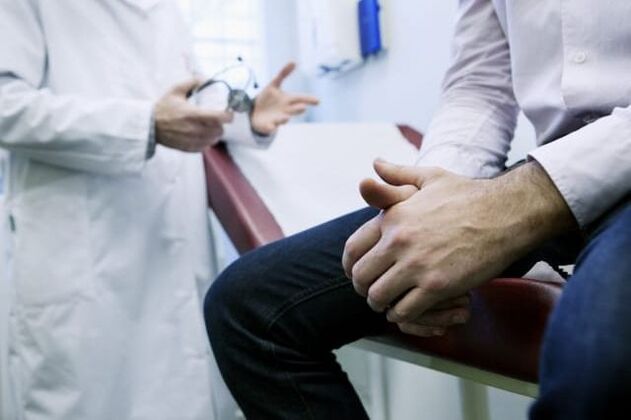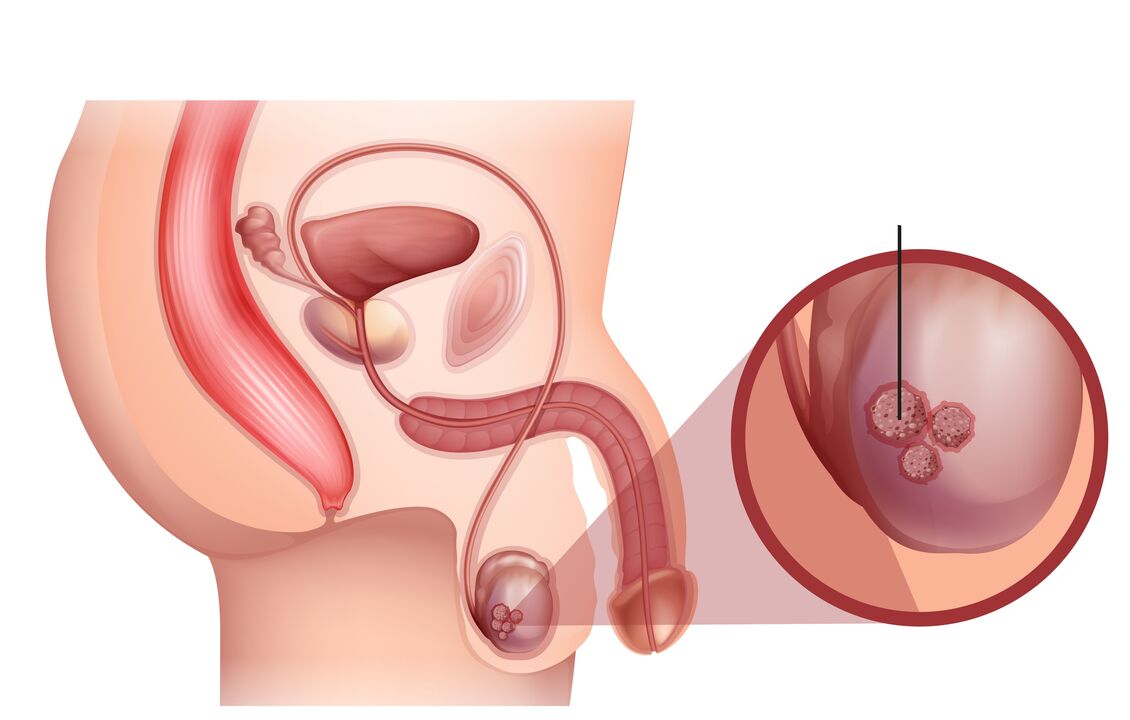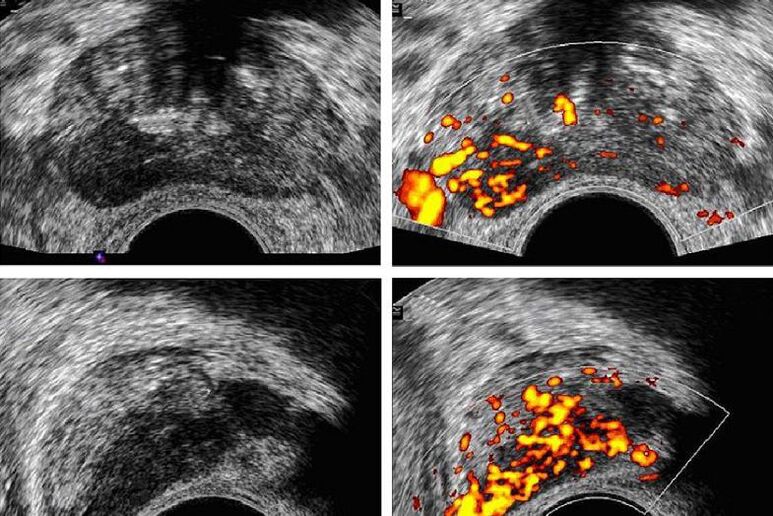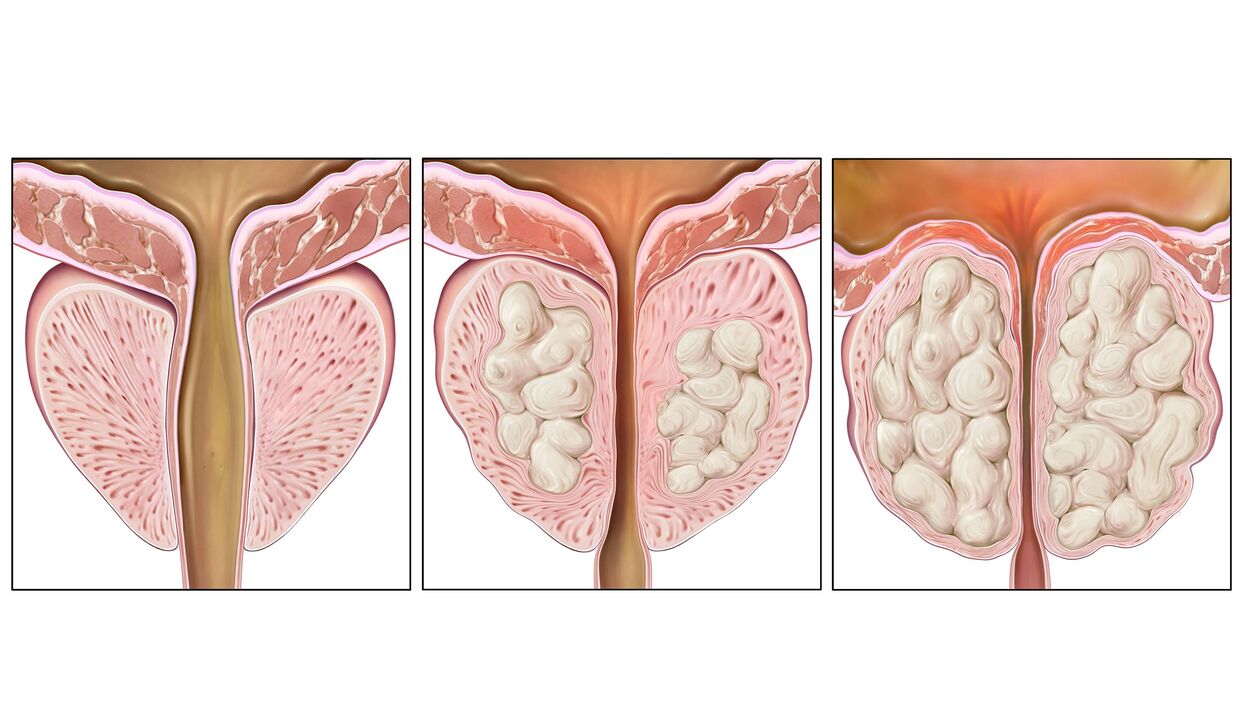
Prostatitis in men is an inflammatory process involving prostate tissue. This disease is accompanied by pain that occurs in the lower back, perineum, in the pelvis. The main manifestation is pain in the perineum and lower urinary tract dysfunction.
Among all urological diseases, urologists most often encounter prostatitis. It can develop unexpectedly (acute) against the background of general health, or continue for a long time, with periods of exacerbation and remission, which indicates a chronic course. Moreover, the second variant of the disease is diagnosed more often.
This disease is independent, and can also be combined with prostate hyperplasia or prostate cancer.
Because of development
Inflammation does not appear by itself. Causes of prostatitis can be divided into bacterial and non-bacterial.
The acute infectious variant usually occurs in men under the age of 35 due to damage to the prostate gland by gram-negative bacteria - Escherichia coli, Proteus, Enterobacter. Also, inflammation occurs as a result of infection with sexually transmitted infections - gonorrhea, chlamydia. In the chronic form, there are many more reasons and the list will include atypical microbes.
Factors that provoke the development of bacterial variants are:
- unprotected sex;
- AIDS or HIV infection;
- diarrhea or constipation;
- anal intercourse;
- sedentary lifestyle;
- inactive sex life;
- diabetes;
- hypothermia;
- violations in intimate hygiene.
- emotional disorders;
- autoimmune diseases;
- increased physical activity;
- lack of a normal sex life;
- work related to heavy lifting;
- chronic stress;
- congestion in prostate tissue;
- previously confirmed fibrotic changes in the prostate (according to TRUS results).
What are the early signs of prostatitis to be aware of?
The first manifestation of this disease is pain in the lower back and perineum, difficulty urinating. If, while going to the toilet, you notice a weak stream of urine, feel discomfort or a burning sensation in the urethra, you should contact a urologist as soon as possible.
With the acute onset of the disease, the temperature may rise, the general well-being worsens. Such patients should be treated immediately by connecting antibiotics, anti-inflammatory drugs.
In some cases, the disease can be asymptomatic for a long time, so it starts late to treat it.
Symptoms of prostatitis
Symptoms of prostatitis in men depend on the form of the disease. In the acute form, the following manifestations are characteristic:
- pain in the lower back, sacrum, perineum;
- frequent or difficult urination;
- acute urinary retention;
- difficulty defecating;
- thin stream of urine;
- temperature increase;
- shivering;
- deterioration in general well-being.
The chronic form may occur after the acute phase of the disease or develop as a primary disease. Symptoms of prostatitis in men with a chronic course are mild. The pain is of low intensity, the temperature may rise slightly. The flow of urine becomes thin, disorders appear in the intimate sphere.
In the chronic course, exacerbation of prostatitis with symptoms characteristic of the acute phase is possible. Pain may be absent or have a dull and aching character.
Symptoms of acute prostatitis
Acute prostatitis occurs in several stages, which will move from each other, if you do not contact a specialist and do not stop the development of the disease in time.
The first stage is called acute catarrhal prostatitis. It starts with complaints of frequent painful urination. In the lower back and sacrum, as well as in the perineum, a slight pain appears at first, which quickly increases.
Without treatment, the second stage occurs - acute follicular. At this time, the pain becomes very strong, it radiates to the anus, and worsens during defecation. Urination is very difficult, sometimes there is acute urinary retention. The temperature does not exceed 38 degrees and only in rare cases can it be higher.
Acute parenchymal prostatitis is expressed in severe intoxication, the temperature reaches 38 ° C and above, chills appear. Urinary retention is often observed, sharp pain, throbbing in the perineum appears, defecation is difficult.
Symptoms of chronic prostatitis
Sometimes chronic prostatitis occurs against the background of an acute inflammatory process. This is a separate disease in which there is a primary chronic course that develops over a long period of time.
Often, the chronic course begins as a complication of the inflammatory process caused by various infectious agents - chlamydia, Trichomonas, gonococcus. But clear manifestations are very rare, more often the disease occurs with a small pain during urination or in the perineum, with a small discharge from the urethra. Often this manifestation is not noticed even by the patient for a very long time.
Signs of prostatitis in men can occur in different ways, but they are all combined into three groups - pain syndrome, urinary disorders, problems with sexual life. Prostate tissue does not have receptors, therefore, they cannot give painful sensations. They appear when inflammation begins to move to the pelvic organs, which are heavily innervated. Pain in patients can be different - from barely noticeable discomfort to strong and intense, which interferes with sleep and the usual lifestyle. Pain can radiate to the sacrum, scrotum, lower back, perineum, so self-diagnosis is useless here.
Problems with urination begin at this time when the prostate increases in volume and begins to squeeze the urethra with a decrease in the lumen of the ureter. There is a frequent urge to urinate, a feeling of incomplete emptying of the bladder. Usually, such phenomena are expressed at the beginning of the disease, in the early stages, then they are compensated by the body, but at a later stage, without adequate treatment, they reappear.
Problems with potency in men can also be expressed in different ways. Patients complain of worsening erections, accelerated ejaculation, decreased sexual arousal. Gradually, sexual disorders become more pronounced, and at an advanced stage, symptoms of prostatitis are added to impotence.
Classification
Experts distinguish several categories of diseases:
- acute bacterial prostatitis, which is characterized by symptoms of bacterial infection. The causative agent of the disease in most cases is Escherichia coli. In somewhat less frequent, enterococci and other bacteria are isolated;
- chronic bacterial prostatitis, which is a recurring form of the disease. The causative agent of this disease is the bacteria E. coli, enterococci, etc. Trichomonas, fungi, chlamydia, viruses, mycoplasmas can also be pathogens;
- chronic pelvic pain syndrome, where the infection is not detected. There are two types: inflammatory and non-inflammatory. Among the causes: autoimmune processes, external factors (hypothermia, overheating), infrequent sex life, low physical activity, infrequent urination;
- Asymptomatic prostatitis, detected by chance during a medical examination.
Only a qualified specialist can accurately name the type of prostatitis and determine the course of treatment after a comprehensive diagnosis based on examination data. You should contact a specialist if you have certain symptoms.
symptoms
The main symptom is a violation of the function of the urinary system. You should contact a specialist if you have the following symptoms:
- if urination is difficult and the urine passes for a while;
- if during a bowel movement there is a discharge from the urethra;
- with a burning sensation in the urethra and perineum;
- if during a bowel movement there are unpleasant sensations in the bladder and prostate;
- if the urge to urinate has increased and become more frequent;
- in case of pain in the rectum;
- if there is purulent bloody discharge from the urethra (floating "threads");
- with a frequent increase in body temperature;
- with the appearance of problems of an intimate nature (weaken erection);
- when an erection appears at night for an unexplained reason;
- if ejaculation during intercourse is too fast;
- if the sensation during orgasm is "erased";
- with rapid general fatigue;
- with the manifestation of an unreasonable state of anxiety or depression, as well as a state of mental depression;
- with frequent depression, manifestations of mental depression in anticipation of complications;
- with general weakness of the body.
To contact a urologist, one or two symptoms are enough. Attempts to self-heal, as a rule, lead to a deterioration in the condition, the transition of the disease to a chronic or severe form. In the worst case scenario, an early visit to the doctor can lead to infertility or complete impotence.

If the patient does not consult a doctor in time or the treatment is neglected, the following symptoms may appear:
- pain in the perineum;
- pain near the scrotum;
- pain at the base of the root of the penis (pain).
Painful pain indicates stone formation. Doctors call infertility a late sign of progressive disease.
Symptoms of acute and chronic prostatitis differ significantly. In particular, in the chronic form, the signs may be mild or not expressed at all.
Acute prostatitis is characterized by obvious symptoms - general pain, pain in the groin area. Men should contact a specialist if:
- the urge to urinate becomes very frequent;
- pain during defecation and urination intensifies in the perineum and radiates to the groin;
- complete emptying of the bladder is impossible;
- the amount of urine formed every day has decreased significantly or urine is not collected;
- fever, frequent headache, general weakness.
Acute bacterial prostatitis is characterized by fever and chills, pain in the lumbosacral region (strong), pain in the perineum and rectum, acute urinary retention, frequent pain in muscles and joints.
Chronic prostatitis is characterized by the following symptoms:
- during urination, the pain in the perineum increases;
- with frequent urging, the bladder is not completely emptied;
- decreased sex drive;
- discomfort during intercourse.
One of the signs of the chronic form is a significant disturbance of the emotional background, which is characterized by insomnia, increased restlessness, instability, irritability.
The bacterial form of chronic prostatitis is characterized by ejaculation problems, which become rapid and painful, discomfort in the genital area, frequent or involuntary urination, and urinary flow disorders.
Chronic pelvic pain syndrome, which, according to medical statistics, is the most common form of prostatitis, is characterized by symptoms similar to the symptoms of chronic bacterial prostatitis: frequent urge to urinate, decreased urine flow, pain in the penis, testicles. , sexual dysfunction.
Possible Complications
- vesiculitis;
- posterior urethritis or colliculitis;
- abscess of the gland itself;
- sclerosis or fibrosis of the prostate;
- prostate cysts and stones;
- infertility;
- ejaculation disorders;
- erectile dysfunction.
Diagnostics
Urologists deal with the diagnosis and therapy of any form of prostatitis. If a tumor is suspected, the patient may be referred to consult an oncologist. In chronic long-term prostatitis, which is difficult to treat, consultation with an immunologist may be necessary.
- Bacteriological culture of urine.
- Analysis of prostate secretions for microflora and sensitivity to antibiotics.
- Rectal examination of the prostate.
- Ultrasound of the prostate gland, which allows to identify tumors, cysts, adenomas, as well as to distinguish prostatitis from other urological and surgical diseases.
- Spermogram to rule out infertility.
Diagnostic features in acute prostatitis
If the signs of the disease indicate acute prostatitis, the diagnosis is made based on instrumental and clinical examination data. Any manipulation that can affect the prostate is contraindicated, because it can cause acute pain or trigger the spread of infection.
Diagnostic features in chronic bacterial prostatitis
The diagnosis in such cases is determined on the basis of the following data: examination by the patient's doctor, bacteriological and microscopic examination of prostate secretions, study of ultrasound data.
Diagnostic features in pelvic pain syndrome
Specialists prescribe diagnostic procedures for symptoms that indicate chronic pelvic pain syndrome, taking into account the type of disease: inflammatory or non-inflammatory. As a rule, ultrasound is prescribed, as well as the following manipulations:
- study of prostate secretion;
- molecular biology research;
- bacteriological research.
The choice of technique is determined by the doctor according to the initial examination.
Risk groups
The most likely occurrence and development of prostatitis:
- in men who are obese or lead an inactive lifestyle;
- in men with sedentary work (office workers, programmers);
- in men whose body experiences tremors and vibrations (car drivers, including special equipment);
- in men with infectious diseases, including diseases of the genitourinary system;
- in men who are sexually hyperactive and in those who do not have frequent sex;
- in men in a state of depression, suffering from mental illness;
- in alcoholics, drug addicts, etc.
Treatment
Patients with acute prostatitis identified without the development of complications are treated on an outpatient basis. Only with severe symptoms of intoxication and suspected purulent process, hospitalization is carried out.
Antibiotics are the drug of choice to fight inflammation. It is also used in the chronic form of bacteria. This drug is selected individually, taken as a course for 4-6 weeks. In severe cases, antibacterial agents are given intravenously, in all other cases - orally, in the form of capsules or tablets.
Another drug used for prostatitis is alpha1-blockers, which are prescribed in the presence of residual urine confirmed by ultrasound. They help facilitate urination, relax the muscles of the prostate and bladder. NSAIDs help relieve pain.
Prostatitis treatment is only carried out comprehensively and consistently. In addition to taking medication, the doctor will prescribe a course of prostate massage, and physiotherapy is used to improve blood circulation in this organ. Surgical treatment is only used when abscesses and suppuration of the seminal vesicles appear.

Treatment options for prostatitis depend on many factors and are determined individually. When choosing a treatment method, the following points are taken into account:
- cause of disease;
- course of illness;
- individual characteristics of the body (presence of chronic and concomitant diseases).
For treatment, a specific technique can be chosen or a complex can be prescribed. Specialists in the field of urology, depending on the results of the diagnosis, prescribe:
- Physiotherapy procedures: magnetic resonance therapy, procedures using laser equipment, ultrasound, reflexology, massage, hirudotherapy.
- Medical treatment.
- diet and psychotherapy.
- Surgical intervention.
When diagnosing bacterial prostatitis, broad-spectrum antibiotics, immunomodulators and multivitamin complexes are prescribed.
When diagnosing non-bacterial prostatitis, physiotherapy and anti-inflammatory drugs are prescribed.
In some cases, specialists may recommend muscle relaxants and hormone therapy, as well as antioxidants that help reduce inflammation and protect cells from free radicals.
Correctly selected drug complex for acute bacterial prostatitis:
- restore immunity;
- treat infections (antibiotics);
- treat the prostate (antibacterial drugs).
Chronic prostatitis is difficult to treat, so a wide list of drugs is used: anti-inflammatory, antispasmodic, absorbable, antibacterial, vibration massage and finger massage, electrophoresis, EHF and UHF therapy, sinusoidal modulated current.
When diagnosing pelvic pain syndrome, antibiotics and anti-inflammatory drugs, various types of physiotherapy, magnetic and laser therapy, electrical nerve stimulation, etc. are used. One of the effective methods is tissue drainage around the focus of inflammation.
Conservative or modern treatment is chosen by a urologist based on diagnostic data.
Tablets
In the form of tablets for prostatitis, antibacterial agents, painkillers can be prescribed.
The course of antibiotic therapy is selected individually depending on the results of the prostate secretion analysis. The microflora that causes the disease must be sensitive to the drugs used. It is necessary to complete the course of treatment prescribed by the urologist, otherwise the cause will not be eliminated, the disease will recur or become chronic.
Painkillers for prostatitis help to get rid of unpleasant symptoms. For this, non-steroidal anti-inflammatory drugs are used, which not only relieve pain, but also relieve inflammation.
Prostatitis pills for men, which help treat urinary problems, belong to the group of alpha 1 blockers. They relax the smooth muscles and restore the patency of the urethra squeezed by an inflamed prostate.
Injections for prostatitis
Antibacterial agents for prostatitis in men are also used in the form of injections. The injectable form of the drug is prescribed for severe inflammation, as well as in the absence of a tablet form of antibiotics, to which the pathogen is sensitive. You can make an antispasmodic injection to restore urination quickly, which is difficult due to the spasm of the urinary tract and compression of their prostate.
Injectable prostatitis medications work faster than oral medications, so they are sometimes preferred.
Surgery for prostatitis
The most formidable complications are seminal vesicle pus and abscesses. Medicines for the treatment of the disease cannot overcome the disease in difficult conditions, therefore, surgery is indicated at the first manifestation.
If there is no timely intervention, the purulent process spreads outside the organ, so the consequences of prostatitis in a complicated form can be life-threatening.
Prediction and prevention
The acute form without treatment often becomes chronic, which periodically worsens. Full recovery is not always possible, however, with timely access to the doctor and taking all prescribed medications, discomfort, urinary problems and pain can be eliminated.
Self-treatment at home and the use of folk methods can often be life-threatening.
To prevent prostatitis, it is recommended to avoid hypothermia, empty the bladder on time, limit the use of coffee, spices and alcohol, and remain sexually active as long as possible.
Common symptoms of prostate cancer

The prostate gland is a small organ that only men have. It resembles a sponge in its structure, is located under the bladder and wraps the urethra. Gland growth begins in adolescence under the influence of male sex hormones; in adulthood, its weight can reach 20 grams. It plays an important role in the male reproductive system, producing secretions, one of the components of sperm. But unfortunately, in mature and old men, hyperplasia of glands or malignant neoplasms of organs are often found.
How to recognize cancer
As the tumor grows and develops, the symptoms of prostate cancer depend on the stage of the process. If the disease is still in the first stage or even reaches the second stage, then the tumor is localized in the prostate gland, does not grow into neighboring tissues and does not allow metastasis.
The symptoms of prostate cancer in the early stages can be said to be non-existent, this is the peculiarity of this disease. The man did not make any complaints, felt well and saw no reason to go to the doctor. That is why often this type of tumor is found already in a neglected state. An exception may be patients who have previously been diagnosed with a benign neoplasm of the prostate gland, in which case they are periodically observed by a specialist doctor and tested for specific prostate antigens, undergoing ultrasound of the gland. They have every chance to detect the tumor at an early stage. But it should be noted that detecting prostate cancer is not always easy. Even with a biopsy, the results may be clear, but there is already oncology. This is due to a method error, the needle just does not fall into the local focal point. If prostate pathology is suspected, especially if cancer is in question, a combined biopsy should be performed, which combines the capabilities of ultrasound and MRI in real time, giving the doctor the opportunity to visualize the organ as precisely as possible.

Some symptoms are the result of prostate pathology, while others are caused by mechanical compression and urethral obstruction.
Since the bladder must be emptied frequently, if this process is disturbed, urine may be retained in it, inflammation may occur, and bacterial infection may join. If no measures are taken, the process will spread, and this is already threatening with pyelonephritis and kidney problems.
At stage 4, prostate cancer manifests itself more clearly. Metastases are most often found in the bones, spine and lymph. Because of this, a person's regional lymph nodes increase, bones hurt, he loses weight suddenly and is weak.

Treating prostate cancer is not an easy task, but it can be done. With timely detection of local processes, a complete cure can be achieved, and with more advanced stages, life can be extended. If you find the symptoms mentioned above, contact a professional clinic for an examination.
Make an appointment, the clinic's doctors have many years of experience in the treatment of urological diseases and achieve success even in the most difficult cases.






























